.
18.08.2013
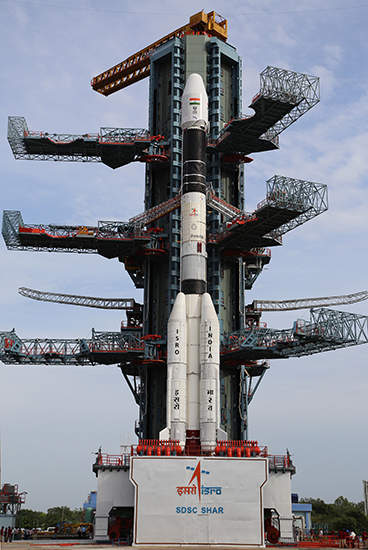
ISRO rocket launch Monday with indigenous cryogenic engine
In a month marked by key advances in indigenously-developed technology, India's space agency will also test its mettle with a crucial rocket, powered by a cryogenic engine built in the country, slated to blast off Monday.
The countdown for the flight of the heavy geosynchronous satellite launch vehicle (GSLV) is set to begin Sunday evening, Indian space agency officials said.
According to Indian Space Research Organisation (ISRO), the 29 hour countdown would start at 11.50 a.m. Sunday and the rocket is expected to blast off at 4.50 p.m. Monday from India's rocket port Sriharikota in Andhra Pradesh, around 80 km from here.
This month has already seen key advances.
As the country celebrated its 67th Independence Day, the month saw activation of the indigenously built small reactor to power submarine INS Arihant, the launch of the indigenously-built aircraft carrier INS Vikrant while a unit of Kudankulam Nuclear Power Project (KNPP) is expected to be connected to the grid month end.
One event that created a shadow was the loss of Indian naval submarine INS Sindhurakshak.
Now eyes are on the ISRO to see whether the GSLV, powered by its own crucial cryogenic engine would successfully deliver its baby-communication satellite - the 1,982 kg GSAT-14 - into outer space.
"After two GSLV failures, ISRO has to prove itself at the earliest possible. There is always a pressure on that count," a senior ISRO official, who did not want to be named, told IANS.
This will be the first mission of GSLV during the last three years after two such rockets failed in 2010.
One of the GSLV rockets flew with Indian cryogenic engine and the other one with a Russian engine.
The GSLV is a three stage/engine rocket. The first stage is fired with solid fuel, the second is the liquid fuel and the third is the cryogenic engine.
The successful flight of this rocket is crucial for India as it will be the first step towards building rockets that can carry heavier payloads, up to four tons.
According to ISRO, several design changes have been incorporated in the Monday's rocket for a safe flight.
Design changes were made in the lower shroud/cover that protect the cryogenic engine during the atmospheric flight; wire tunnel of the cryogenic stage to withstand larger forces during the flight; and the revised aerodynamic characterisation of the entire rocket.
Others included video imaging of lower shroud movement during various flight phases; fuel booster in cryogenic engine; and ignition sequence of the cryogenic engine.
ISRO said indigenisation of many critical systems including liquid hydrogen propellant acquisition system (to prevent possibility of outside contamination) was achieved.
It is going to be a tense 17 minutes for the ISRO scientists Monday after the 49.13 metre tall rocket weighing 414.75 ton blasts off at 4.50 p.m. till the GSLV rocket safely delivers GSAT-14 to augment the Indian transponder - receivers and transmitters of signals - capacity.
ISRO is planning to launch an upgraded version of GSLV Mark III rocket next year with a dummy payload. The design payload capacity of GSLV Mark III is four tons.
Meanwhile an ISRO official said the fuelling of the three stage/engine GSLV rocket's four strap-on motors and the second stage with liquid fuel will be completed by Aug 19 morning while the first stage core engine is powered by solid fuel.
The process of fuelling the cryogenic engine will begin around 10 hours prior to the launch.
.
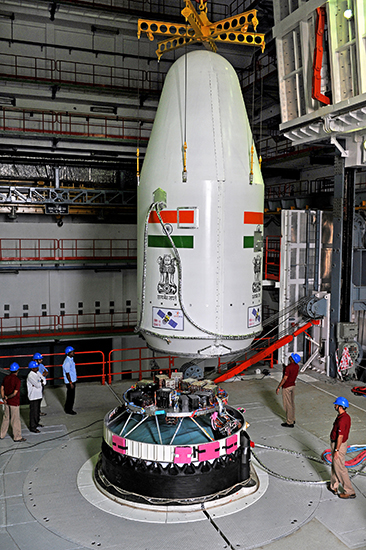
.
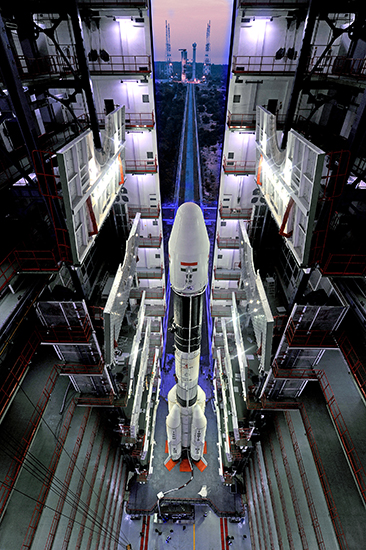
.
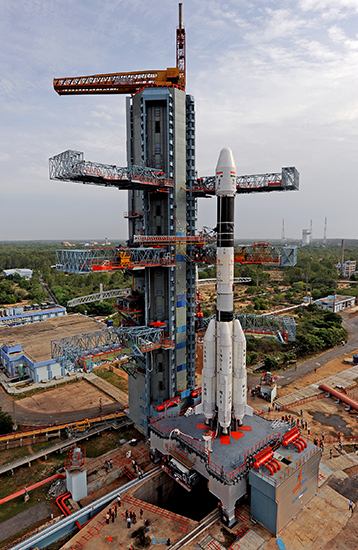
GSLV-D5 at the Second Launch Pad
Quelle: ISRO
.
Indian space science is waiting at the threshold of a new phase of mega satellite launches and exploration as the countdown for the GSLV-D5 rocket launch began at 11.50am on Sunday. Twenty-nine hours later, at 4.50pm on Monday, the rocket carrying telecommunication satellite GSAT-14 will lift off from Sriharikota, 100km north of Chennai.
GSAT-14, which weighs 1,982kg, will be used for telecast and telecommunication.
What makes the launch crucial for the nation is the use of an indigenous cryogenic engine as the upper stage. The first attempt to use an indigenous cryogenic engine on April 15, 2010 to power GSLV-D3 was a failure. With only one more Russian cryogenic engine left in the Isro arsenal, success of the indigenous technology using oxygen and hydrogen in extreme low temperatures as the fuel will propel several big ticket future missions including a manned project to space.
Isro senior scientists led by chairman K Radhakrishnan are monitoring GSLV-D5, whose strap-boosters started getting fuelled soon after the countdown. Liquid propellants are being filled into the second stage. Liquid hydrogen and liquid oxygen, which fuel the cryogenic engine will be filled around 9am on Monday. Scientists at the Satish Dhawan Space Centre told TOI that the rocket's health and weather conditions were fine.
India needs cryogenic engines to launch GSLVs that can carry payloads weighing more than three tonnes, which hold the key to future of telecommunication and space exploration. GSLV-D5 weighs 414 tonnes.
Since 1994, India has had 23 consecutive successes with the Polar Sateliite Launch Vehicles (PSLVs), an improvised version of which was used for Chandrayaan-1 in August 2009. However, PSLVs can carry only payloads weighing up to 1.5 tonnes to a geosynchronous transfer orbit (a highly elliptical orbit with the nearest point to earch about 200km and the farthest 42,00km) , and up to 3.5 tonnes to a low earth orbit of about 200km from earth. GSLV can carry payloads weighing 2.5 tonnes to a geosynchronous transfer orbit, and up to 5 tonnes to a low earth orbit.
Quelle: The Times of India
.
UPDATE: 21.45 MESZ
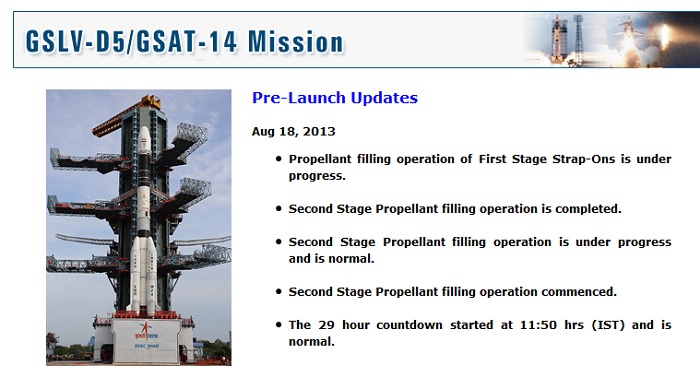
Quelle: ISRO
.
Update: 19.08.2013
.
The 29-hour countdown for the launch of indigenously developed geo-synchronous satellite launch vehicle D5 (GSLV-D5), along with communication satellite GSAT-14, scheduled to blast-off on Monday at Satish Dhawan Space Centre (SHAR) in Sriharikota is progressing smoothly.
“The countdown which started at 11:50 am is progressing well and the process of filling liquid propellant to the rocket is in progress,” a senior official from the Indian Space Research Organisation (Isro) told Deccan Herald on Sunday.
The official said that liquid propellants are being filled into the second stage. Liquid hydrogen and liquid oxygen, which fuel the cryogenic engine, will be filled around 9 am on Monday, he added. Though the Met department has predicted heavy rain over the coastal region in the next 24 hours due to upper air cyclonic circulation over the Bay of Bengal, Isro officials were confident that the launch would not be affected.
The mission assumes significance as the indigenously developed cryogenic upper stage (CUS) will be flight tested for the second time.
Quelle: Deccan Herald
-
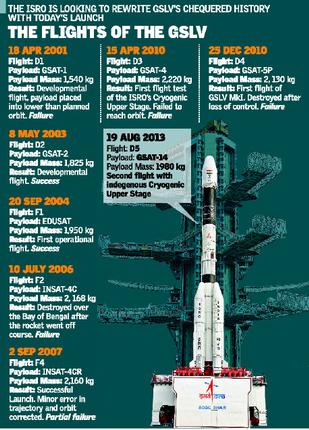
After years of effort and back-to-back failures, today’s GSLV launch is crucial to ISRO’s quest for an indigenous cryogenic engine
Once again, a Geosynchronous Satellite Launch Vehicle (GSLV) is on the launch pad at Sriharikota. This launch will be crucial — after two successive failures of the rocket, the Indian Space Research Organisation can ill afford one more troubled flight. Moreover, the space agency needs to demonstrate that, after 20 years of effort, it has now mastered cryogenic technology.
The GSLV retains the first two stages of its predecessor, the Polar Satellite Launch Vehicle (PSLV). In order to carry heavier satellites than the latter, the third stage of the GSLV uses cryogenic propulsion. Running on liquid hydrogen and liquid oxygen, a cryogenic engine offers greater energy efficiency than those that use other propellants. The improved efficiency means that the upper stage can carry less propellant, with the weight saved translating directly into more payload.
ISRO tried to purchase cryogenic technology from what was then the Soviet Union, but the deal that was signed in 1991 ran into trouble after the U.S. imposed sanctions. Russia, which inherited the deal after the breakup of the Soviet Union, backed out of providing the technology but agreed to supply seven flight-worthy stages for the GSLV. (For more details see “The long road to cryogenic technology,” The Hindu, April 15, 2010).
Left with no option, ISRO began the Cryogenic Upper Stage Project in April 1994 for developing an indigenous version of the Russian cryogenic engine and stage. While this technology development was in progress, it could fly the GSLV with Russian-made stages.
The GSLV, equipped with a Russian cryogenic stage, first flew in 2001. However, unlike the PSLV, which shook off the failure of its first launch and went on to notch up 23 consecutive successes, the GSLV has been trouble prone. In its seven flights so far, three were outright failures and another two suffered serious problems.
In April 2010, the GSLV flew for the first time with an indigenous cryogenic stage. Close to five minutes after lift-off, the cryogenic engine came to life but only very briefly. With thrust from that engine failing to pick up, the rocket soon tumbled into the sea.
In December the same year, the GSLV was flown again, this time with a Russian cryogenic stage. But disaster struck yet again, with the vehicle going out of control less than a minute into the flight, breaking up into pieces and exploding into flames over Sriharikota.
ISRO has gone to great lengths to learn from those failures and adopt suitable changes, say senior officials of the space agency.
The Russian cryogenic engine and stage design is complicated. Booster turbopumps installed at the bottom of the liquid hydrogen and liquid oxygen tanks maintain a steady flow of propellants to the main turbopump.
Glitch rectified
Analysis of the data radioed down by the rocket during its April 2010 flight showed that the booster turbopump supplying liquid hydrogen had caused the problem. The turbopump had started up normally and attained a maximum speed of 34,800 revolutions per minute. But its rotation slowed after less than one second and stopped soon afterwards.
A detailed review concluded that one of the pump’s seals could have gripped the rotating shaft as a result of thermal deformation or some tiny contaminant becoming wedged somewhere. Alternatively, the casing of the turbine that drives the pump could have ruptured.
The review led to a tightening of manufacturing tolerances for the booster turbopump’s parts as well as more stringent procedures for its assembly. Extensive testing has also been introduced, including of the fully-assembled turbopumps.
The starting sequence for a cryogenic engine is a complex process, involving split-second timing. The cryogenic engine as well as the stage’s two small steering engines were tested briefly under simulated high-altitude conditions at ISRO’s Mahendragiri facility in Tamil Nadu to ensure that their ignition went smoothly.
In the GSLV’s December 2010 flight, a shroud, which protects the cryogenic engine during atmospheric flight, opened up as the rocket accelerated to supersonic speeds. In the process, it pulled apart connectors for electrical cables carrying control signals from onboard computers mounted near the top of the rocket to the rest of the vehicle. Out of control, the vehicle turned sharply and soon broke up. The shroud has now been strengthened and the connector mounting modified.
In its forthcoming mission, the GSLV is carrying GSAT-14, a communication satellite weighing close to two tonnes.
The rocket could launch seven more spacecraft over the next four years, according to ISRO Chairman K. Radhakrishnan. This could include four communication satellites, a meteorological satellite identical to the Insat-3D that was launched last month on Europe’s Ariane 5 rocket, the GISAT remote sensing satellite as well as Chandrayaan-2, the country’s next lunar exploration mission.
The cost of launching Insat-3D on Ariane 5, not including insurance, came to $82 million (Rs.490 crore), Dr. Radhakrishnan told this correspondent. The ‘marginal cost’ of each GSLV — that is, the additional expense the space agency incurs on the launch vehicle but which does not include all the organisational costs and investments for supporting the mission — came to about Rs.200 crore.
However, the current version of the GSLV will probably not be able to carry communication satellites weighing more than about 2.2 tonnes. ISRO has already launched several considerably heavier communication satellites aboard Ariane rockets. The Department of Space’s latest annual report shows eight more communication satellites being launched abroad over the next four years, including the GSAT-7 that will fly on the Ariane 5 later this month.
ISRO is in the process of developing a more powerful rocket, the GSLV Mark-III, that will be capable of carrying four-tonne-class communication satellites. The rocket’s giant solid propellant booster and its big liquid propellant stage have already been successfully tested on the ground. But an entirely new cryogenic engine and stage have also to be prepared.
Test firing of the GSLV Mark-III’s cryogenic engine would start soon and the intention was to have the entire vehicle ready for its first developmental flight by 2016-17, according to the ISRO chairman.
Quelle: The Hindu
-
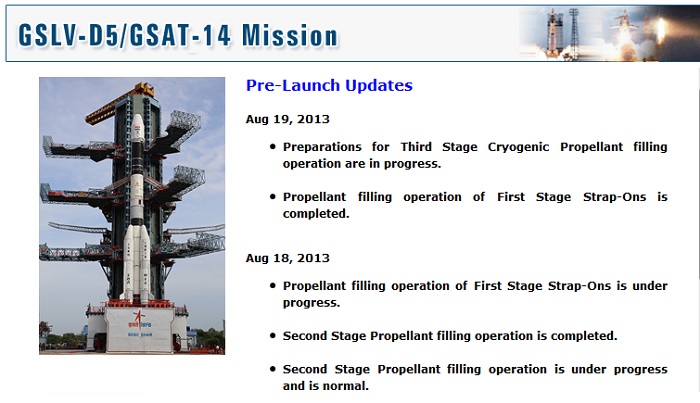
Quelle: ISRO
.
Update: 19.08.2013 / 14.00 MESZ
GSLV-D5 Launch Called-Off
The Launch of the GSLV-D5 scheduled for 1650 hrs today (August 19, 2013) is called off, as a leak is observed in the UH25 fuel system of the liquid second stage during the pre-launch pressurisation phase on the vehicle just two hours before the scheduled lift-off.
The propellants are being drained from the Cryogenic Stage, Liquid Second Stage and the four liquid Strap-ons of GSLV-D5. The vehicle will be moved back to the Vehicle Assembly Building for further actions.
The revised launch date will be announced after a detailed assessment.
Quelle: ISRO
.
Update: 20.08.2013
.
ISRO may use standy engine to launch GSLV
Indian space agency ISRO will look at options of using a standby engine for the early launch of its heavy geosynchronous satellite launch vehicle (GSLV) after examining what forced the postponement of the launch Monday, an official said.
"We have a standby for the second stage engine. But first we have to study the problem. If the problem is due to a faulty component, then we have to look at the batch to which the component belonged and have to replace the entire components from that batch," an Indian Space Research Organisation (ISRO) official told IANS preferring anonymity.
He said there was no point in replacing an engine with another faulty one.
According to him, ISRO will look at different options like using a standby engine, replacing the component or correcting the problem.
"If the problem is external, it will be easy to correct. But if it is internal, then the engine may have to be dismantled," he said.
ISRO had called off the launch of its GSLV rocket carrying the communication satellite GSAT-14 after the liquid fuel started leaking like a tap from the rocket's second stage.
The GSLV is a three stage/engine with four strap-on motors hugging the first stage. The first stage is powered by solid fuel while the four strap-on motors and the second stage are powered by liquid fuel. The third is the cryogenic engine powered by liquid hydrogen and liquid oxygen.
"This is the first time we have seen such a fault," said a source close to ISRO.
According to officials, the second stage is identical for ISRO's two rockets - its lighter rocket polar satellite launch vehicle and GSLV.
While GSLV is under the development stage, the PSLV is termed as the space agency's workhorse and used to launch Indian and foreign satellites.
In 2010, ISRO had to postpone a PSLV launch as it found "a marginal drop in the pressure in the second stage of the vehicle during mandatory checks".
At that time the faulty part was inaccessible as the rocket stages had been fully assembled. ISRO had to dismantle the second stage to correct the fault.
In 2013, ISRO had to postpone the launch of its PSLV rocket carrying India's first navigational satellite after it found a problem in one of the electro-hydraulic control actuators in the second stage.
Here again, the fully assembled rocket had to be dismantled to replace the actuator, an assembly of several components.
In both cases, the second stage was not fuelled up and hence did not pose a problem for ISRO.
But the problem in the GSLV supposed to fly Aug 19 is complex as the leaking second stage was fuelled up and the third and critical stage - the cryogenic engine - was being fuelled for its flight.
"Some of the components in the second stage, like sealants, have limited life after fuelling. They might become brittle if not used within a specified period," officials told IANS.
The one comforting factor is that the crucial cryogenic engine is safe and it does not face such limited life component problems, an ISRO official IANS.
According to them, the first task for them is to drain the fuel from the second and third/cryogenic stage.
Following that, the engines will be decontaminated for fuel and traces of fuel.
"Then the rocket will be moved back to the assembly building and a detailed study of the problem will be made and corrective action will be taken," the official said.
However, ISRO officials could not say when the rocket would be ready for launch.
"Advanced countries test their stages several times before it is used in a rocket. In India, owing to vendor constraints, we have to make our rockets operational after a few tests," R.V. Perumal a retired ISRO rocket expert said.
Quelle: BS-India
.
Update: 22.08.2013
Chennai: The Indian space agency will be able to take its heavy rocket geosynchronous satellite launch vehicle-development 5(GSLV-D5) back to the rocket assembly building either Saturday or Sunday, a senior official said.
"Our current priority is to clean the rocket's fuel systems and disconnect all the hoses and other connections to the second launch pad. This process would take a couple of days. We will be able to move the rocket to the assembly building Saturday or Sunday," the official, preferring anonymity, told IANS Wednesday.
India's spaceport is located in Sriharikota in Andhra Pradesh, around 80 km from here.
The Indian Space Research Organisation (ISRO) Monday called off the launch of its GSLV rocket carrying the communication satellite GSAT-14, after the liquid fuel started leaking like a tap from the rocket's second stage.
The GSLV is a three-stage launch vehicle with four strap-on motors hugging the first stage.
The first stage is powered by solid fuel, while the four strap-on motors and the second stage are powered by liquid fuel. The third is the cryogenic engine powered by liquid hydrogen and liquid oxygen.
Another senior official told IANS that the rocket's engines would have to be decontaminated with ionized water and that would take two or three days.
The entire fuel in the rocket's four strap-on motors, second and cryogenic engine had been drained out Tuesday -- other activities are in progress.
According to officials, only after studying the problem and the solution could revised launch time be estimated.
Asked about earlier problems in the second stage of ISRO's lighter rocket polar satellite launch vehicle (PSLV) (both PSLV/GSLV have identical second stage), the official said: "Rocket engines are complex systems. A small problem might lead to a catastrophic result. It is good that the problem was detected on the ground."
He said if it was a design defect, it would have shown up much earlier, as more than 20 PSLV rockets have been successfully flown by India.
"A pattern could be drawn only if the problem crops up consistently in a component/system," he said.
In 2010, ISRO had to put off a PSLV launch as it found "a marginal drop in the pressure in the second stage of the vehicle during mandatory checks".
At that time, the faulty part was inaccessible as the rocket stages had been fully assembled. ISRO had to dismantle the second stage to correct the fault.
In June 2013, ISRO put off the launch of its PSLV rocket carrying India's first navigational satellite after it found a problem in one of the electro-hydraulic control actuators in the second stage.
Here again, the fully assembled rocket had to be dismantled to replace the actuator, an assembly of several components. The launch occurred successfully July 1 this year.
An expert in rocket technology who retired from ISRO, on condition of anonymity, told IANS that the Indian space agency cannot take any chances with its PSLV rocket as it is also being used for launching foreign satellites.
Quelle: INDIA-TV
.
Update: 23.08.2013
GSLV Neustart wird mehrere Monate dauern
.
.
Update: 31.08.2013
Restoration of GSLV-D5 Mission
The launch of GSLV-D5 (with Indian Cryogenic Stage), scheduled for 1650 hrs on August 19, 2013, had to be called off due to a leak observed in the UH25 Fuel system of the Liquid Second Stage, during the last lap of the countdown. At the time of calling off the Countdown, the GSLV Vehicle was loaded with 210 tons of liquid and cryogenic propellants. About 750 kg of UH25 Fuel had leaked out, leading to contamination of the area around the launch pad. It took 6 days of round-the-clock operations before the contamination could be reduced to the safe level to enable movement of the GSLV-D5 back to the Vehicle Assembly Building. The GSLV-D5 Launch Vehicle has been safely moved back to the Vehicle Assembly Building on the early morning of August 26, 2013. The Vehicle has been de-stacked.
Chairman, ISRO constituted a High Level Task Team on August 20, 2013, chaired by Shri K. Narayana, (former Director of Satish Dhawan Space Centre) to identify the cause of the leak and to work out an action plan for quick restoration of the Mission, taking into account the safety, reliability and life of the Liquid Second Stage and the four Liquid Strap-on stages, which were wetted with liquid propellants. The leak is suspected to be in the lower portion of the propellant tank or the fluid lines between the tank and fuel filling system of the Second stage. Detailed investigation of the leak is underway.
Quelle: ISRO
.
Update: 18.11.2013
.
.
Update: 16.12.2013
.
.
Update: 20.12.2013
.
Isro targeting a 5 January launch for GSLV-D5
The flight test of rejuvenated Geo-synchronous Satellite Launch Vehicle (GSLV-D5) with indigenous cryogenic engine is likely to take place on January five from the space port of Sriharikota in Andhra Pradesh, Indian Space Research Organisation (ISRO) said.
ISRO’s Mission Readiness Review (MRR) team will meet on December 27 to take a final call on the launch of GSLV-D5. Its mission was aborted at the 11th hour on August 19, this year due to a fuel leak in its second stage.
"We have targeted the launch on January 5 afternoon; MRR team will meet on December 27 to take stock of the readiness and will finalise the date and time for the launch", ISRO spokesperson Deviprasad Karnik told PTI.
GSLV-D5 will put the communications satellite GSAT-14 into orbit.
All the three stages of the vehicle have already been integrated, Karnik said, adding, the "satellite will be mated with the launch vehicle next week". He said, "....Everything should be ready by December 26, MMR team will meet on December 27. It will review and decide on the launch".
The launch of GSLV-D5 scheduled at 1650 hours on August 19 from Satish Dhawan Space Centre (SDSC) at Sriharikota, was called-off after a leak was detected in the fuel system of the liquid second stage in pre-launch pressurisation phase on the vehicle, just two hours before lift-off.
The propellants were later drained from the cryogenic stage, liquid second stage and the four liquid strap-ons of GSLV-D5 and the vehicle was moved back to the Vehicle Assembly Building in SDSC.
Fuel tank made of aluminium alloy called Afnor 7020 tended to develop crack over a period of time and the leak was blamed on it.
In response to a question, Karnik said, "It is entirely a new tank this time".
.
It will feature an indigenous cryogenic engine in its third stage
The refurbished Geo-synchronous Satellite Launch Vehicle (GSLV-D5) is getting ready to lift off at 4.18 p.m. on January 5, 2014, from the second launch pad at Sriharikota and it will put the communication satellite GSAT-14 into orbit. The GSLV-D5 will feature an indigenous cryogenic engine in its third, uppermost stage.
“We are moving towards the launch by January 5,” said K. Radhakrishnan, Chairman, Indian Space Research Organisation (ISRO). “All the four stages of the vehicle have already been integrated. The satellite will be mated with the launch vehicle by December 27,” he added.
‘All checks completed’The Mission Readiness Review (MRR) team will meet on December 27 to give the formal clearance for the launch. “By then, everything would have been inspected. All checks on the vehicle would have been completed. Phase III, level I checks have already been done,” said Dr. Radhakrishnan.
ISRO is looking forward to this launch because the GSLV-D5 uses an indigenous cryogenic engine and the vehicle suffered a major snag on August 19, 2013 on the day of the launch. About 75 minutes before the lift-off, the liquid fuel in the propellant tank in the rocket’s second stage started leaking and rained down on the vehicle, forcing ISRO to call off the launch. Fumes engulfed the first and second stages of the vehicle, causing tense moments.
The leak was blamed on the fuel tank made of aluminium alloy called Afnor 7020 which tended to develop cracks over a period of time. The GSLV-D5 was dismantled and the “restoration process” done under the guidance of K. Narayana, former Director, Satish Dhawan Space Centre, Sriharikota. The GSAT-14 communication satellite, which was encapsulated in the heat shield, was preserved and tested periodically.
Since the liquid fuel leaked from the second stage tank made of aluminium alloy Afnor 7020, the Liquid Propulsion Systems Centre (LPSC), ISRO, Mahendragiri, Tamil Nadu, came up with a new second stage with its propellant tank made of aluminium alloy 2219. The four strap-on booster motors were refurbished. The rocket’s first stage, which uses solid propellants, has been replaced with a new one. The restored vehicle has new electronic components because the components in the four strap-on motors in the earlier vehicle had become wet from the fuel leak.
‘Critical components tested’“Everything is going perfectly well [for the launch on January 5],” said M.C. Dathan, Director, LPSC, on Saturday evening. “Eighty per cent of the systems in the GSLV-D5, including the four strap-on liquid motors, the second liquid stage and the cryogenic stage are from the LPSC,” he said. The GSLV-D5’s cryogenic stage had been stored for the past three months-and-a-half. Mr. Dathan added: “The cryogenic stage’s critical components and valves have been tested, and found in good condition. There are three levels of checks on the vehicle. Phase III, level I checks have been done. This means all the fluid lines and electrical circuits have been checked. Everything is giving results as expected. We are ready to go ahead with the launch.”
The GSLV-D5 is a three-stage, 414-tonne and 49-metre tall vehicle.
.
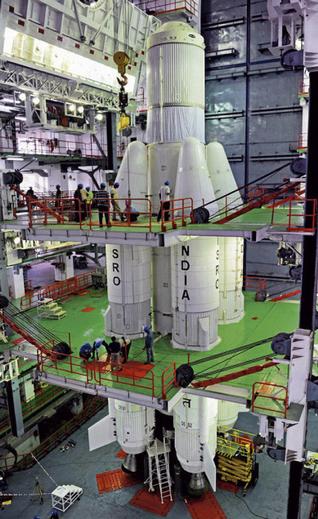
The four strap-on booster motors of the GSLV-D5 being strapped around the rocket’s core in the first stage in the Vehicle Assembly Building of the second launch pad at Sriharikota in December 2013.
Quelle: The Hindu
.
Update: 28.12.2013
.
Preparations reviewed for GSLV-D5 launch on Jan 5
THIRUVANANTHAPURAM: After the Mission Readiness Meet on Friday for the launch of the GSLV-D5 from Sriharikota, ISRO officials informed that the vehicle will be moved to the launch pad on Saturday for the launch set for Jan 5.
"The mission readiness meet went on well and the vehicle will move to the launch pad tomorrow for its launch on Jan 5," Vikram Sarabhai Space Centre (VSSC) director S Ramakrishnan told TOI.
"This readiness for the successful launch of GSLV-D5 will prove effective for the next Mars Mission after two years, as the window for its launch comes once in two years," he said. Current Mars Mission through PSLV-C25 has a limited payload to carry five instruments, while the GSLV will have a heavier satellite payload, he said.
Earlier in Aug 19 this year, an anomaly in the second stage of liquid propellant of GSLV-D5 prompted ISRO to call off the launch. Now, it is all rectified and the third stage indigenous cryogenic engine too has been tested and is ready for GSLV-D5 launch, he said. A high-end version of the heavy cryogenic engine C-25 stage is being designed with 25 ton propellant loading and 20 tonnes of engine thrust for the GSLV MK-3 D-1 mission in early 2017, he said. The huge cryogenic engine is slated for completion and testing by 2015, he said.
The preparations regarding the readiness of the satellite launch vehicle for the mission has been reviewed and currently the launch of GSLV-D5 is set for Jan 5, Liquid Propulsion Systems Centre (LPSC) director M Chandradathan told TOI.
More than 100 scientists from ISRO establishments including VSSC, LPSC and Isro Inertial Systems Unit are at Sriharikota for the GSLV-D5 launch.
Simultaneously, the preparations are on for two more PSLV launches slated in the first quarter of next year including India's Remote Sensing Satellite IRNSS-1B and French satellite Spot 7, PSLV project director P Kunhikrishnan said.
Quelle: THE TIMES OF INDIA
.
Update: 30.12.2013
.
GSLV-D5 launch cleared by Isro's team
29-hour countdown for the launch is expected to commence on January 4
.
The Indian Space Research Organisation's (Isro) Mission Readiness Review (MRR) team and the Launch Authorisation Board (LAB) have cleared the GSLV-D5/GSAT-14 launch, which is scheduled for January 5, 2014.
The 29-hour countdown for the launch is expected to commence on January 4.
Isro said on Saturday that the MRR and LAB have cleared the launch and the launch time was fixed at 16:18 hours (IST) on January 5, 2014.
The vehicle has been moved from the vehicle assembly building to the umbilical tower (the launch pad) on December 28, 2013, it added.
After three continuous failures, GSLV (Geosynchronous Satellite Launch Vehicle) is now getting ready for its new mission and this time Isro, which successfully concluded crucial stages of the Mars Mission, is confident that the launch will be successful.
The mission of the GSLV-D5 would be to carry the advanced communication satellite GSAT-14 into orbit. The GSAT-14 will be used for telecasting and telecommunication purposes. Its mission life is 12 years.
The vehicle carries indigenous cryogenic engine, which will be used for the second time in the GSLV. It was developed by ISRO’s Liquid Propulsion Systems Centre (LPSC) at Mahendragiri, near Nagercoil in Tamil Nadu. The first flight, which used the Indian made cryogenic engine, failed in April 2010.
This would be the eighth flight of GSLV and the second flight of GSLV with the indigenous cryogenic upper stage (CUS) developed by the Liquid Propulsion Systems Centre (LPSC) of Isro.
It may be noted that the GSLV-D5 was scheduled for launch at 16.50 hrs on August 19, 2013, from Satish Dhawan Space Centre at Sriharikota, but the launch was called off at the last minute after a leak was found during the pre-launch pressurisation process in the fuel system of the liquid second stage.
The GSLV was first launched with GSAT-1 on April 18, 2001, which was a successful mission.
Out of the seven GSLV launches earlier, three were unsuccessful. The GSLV-F02 launched with INSAT-4C on July 10, 2006, GSLV-D3 launched with GSAT-4 on April 15, 2010 and GSLV-F06 launched with GSAT-5P on December 25, 2010 were unsuccessful, according to the Isro website. In the first mission, the GSLV-D1, the Russian Cryo underperformed and in 2007, in the GSLV-F04 mission, one strap-on control met with failure though both the missions were successful.
Quelle: BS
.
Update: 1.01.2014
.

Quelle: ISRO
.
Update: 4.01.2014
.
29-hour countdown for launch of GSLV-D5 commences
The 29-hour countdown for the launch of ISRO's rejuvenated Geo-synchronous Satellite Launch Vehicle (GSLV-D5) commenced at 11.18 am today at Satish Dhawan Space Centre at Sriharikota.
"The 29-hour countdown for tomorrow's launch at 4.18 PM of GSLV-D5 carrying 1,980 kg GSAT-14 communication satellite commenced as planned and is progressing smoothly," ISRO spokesperson Deviprasad Karnik told PTI.
The GSLV-D5's first mission attempt with indigenous cryogenic engine was aborted at the eleventh hour on August 19 last year due to a fuel leak in its second stage.
Fuel tank made of aluminium alloy called Afnor 7020 tended to develop crack over a period of time and the leak was blamed on it.
The GSLV is designed to inject its passenger spacecraft into the intended Geosynchronous Transfer Orbit with a combination of solid, earth-storable liquid and cryogenic propellants in it?s first, second and third stages, respectively.
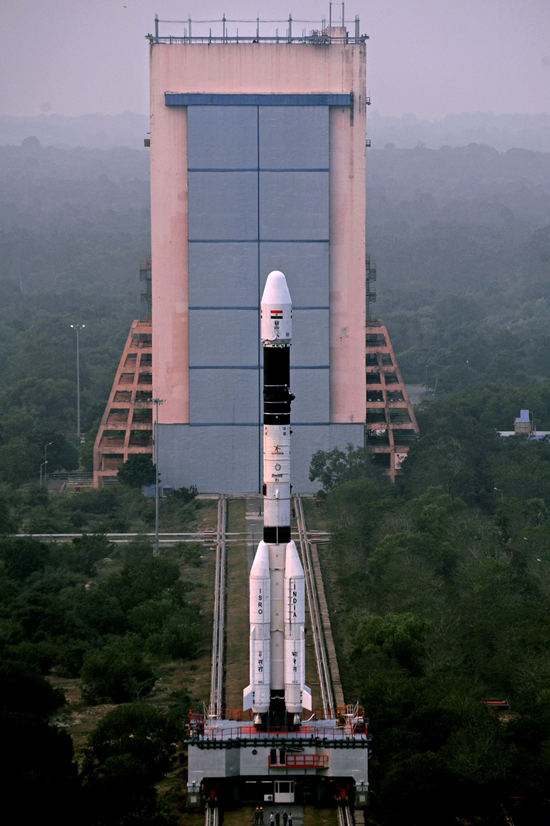
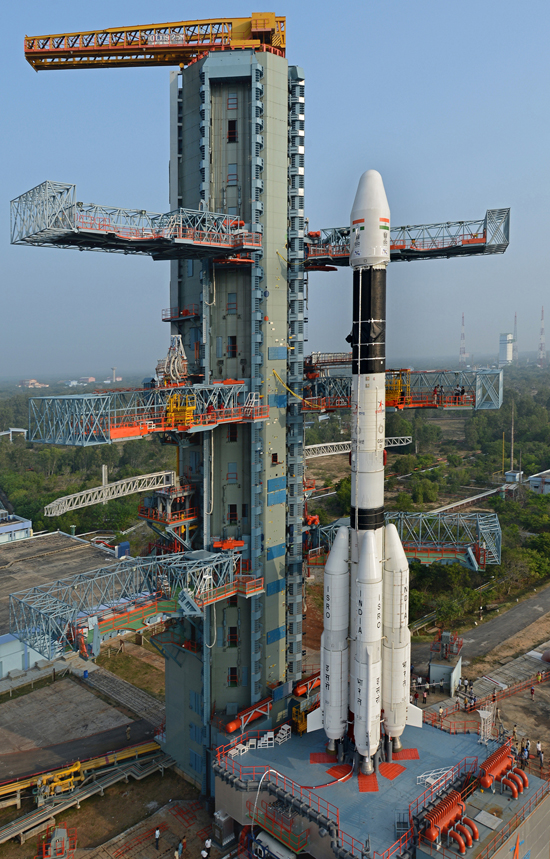
Quelle: hindustantimes / ISRO
.
Update: 5.01.2014
.
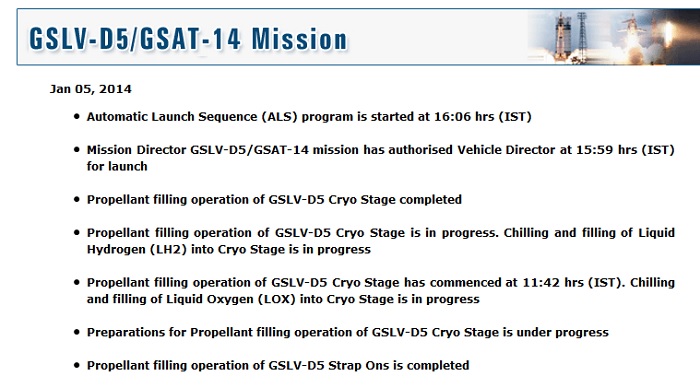
Quelle: ISRO
.
Update:
-

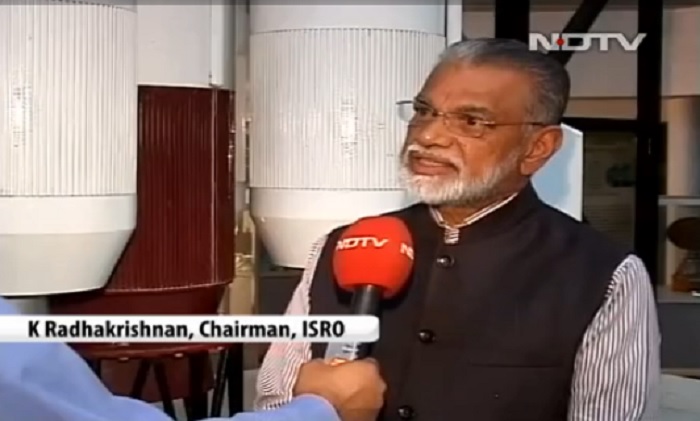
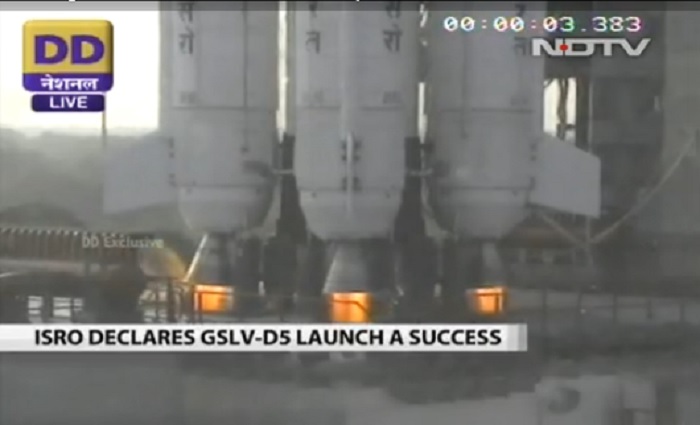
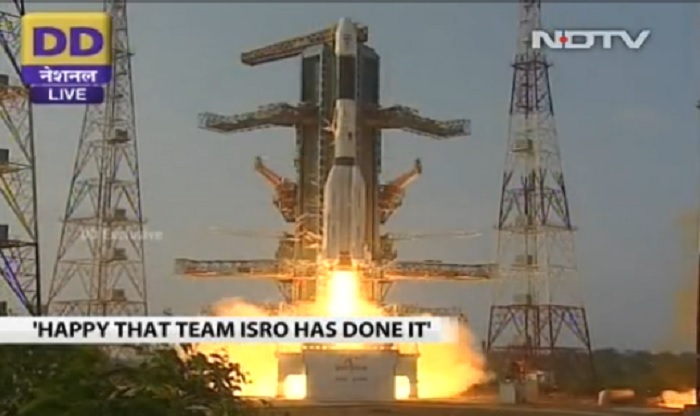

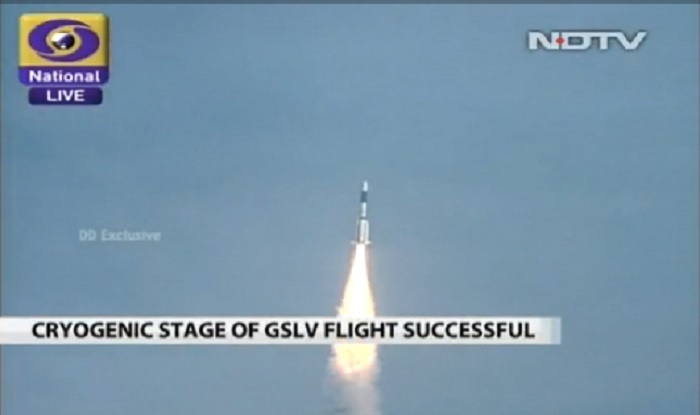
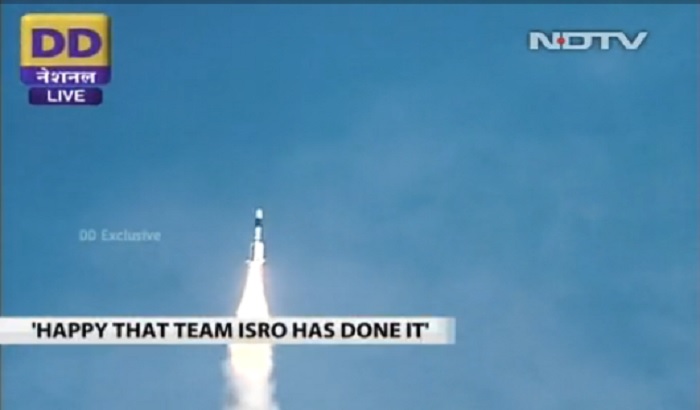
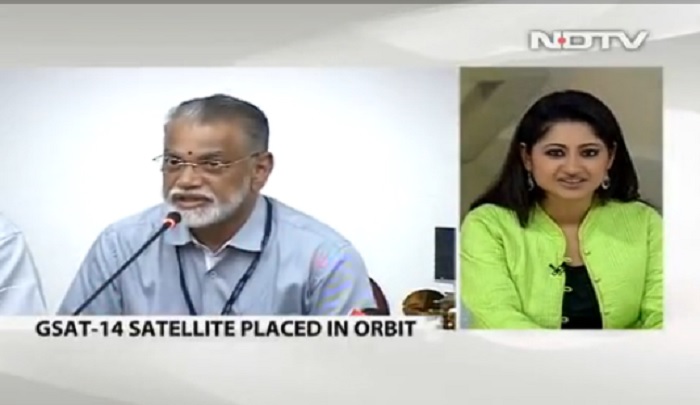
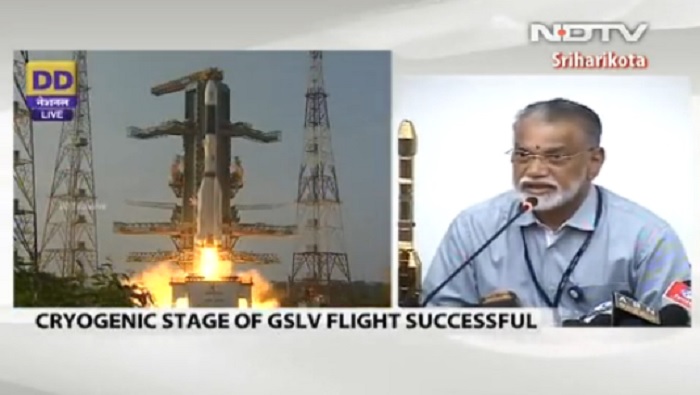
Quelle: Frams - NDTV
.
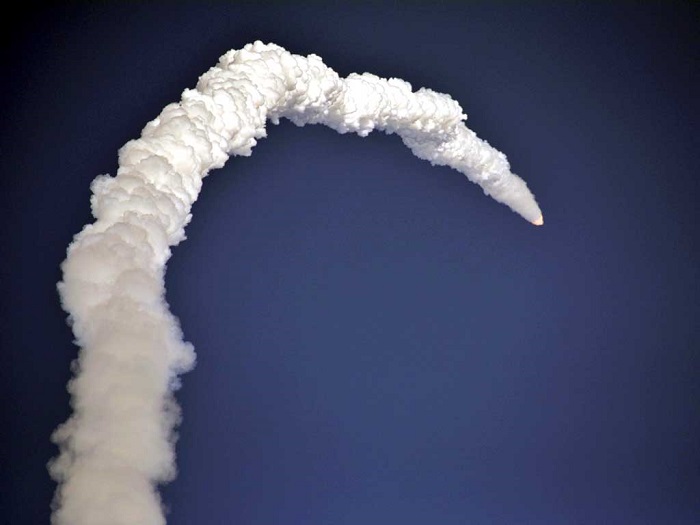
.
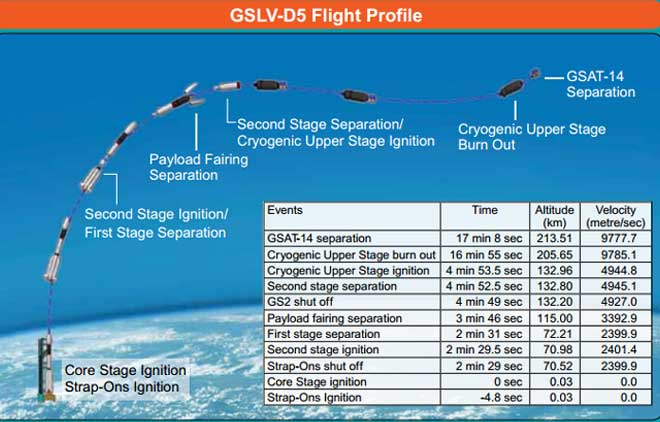
.
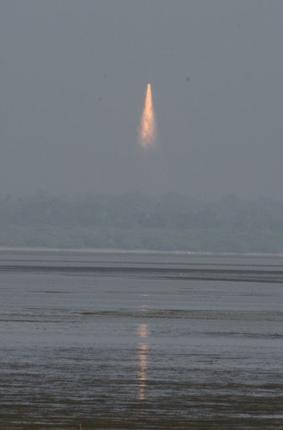
.
Update:
.
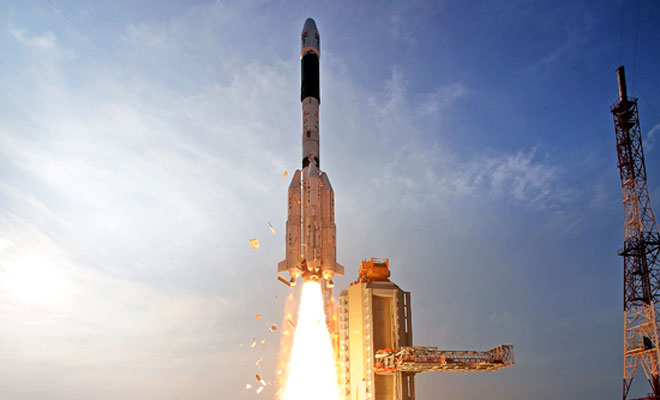
.

India successfully launched rejuvenated indigenous cryogenic engine- fitted GSLV-D5 carrying communication satellite GSAT-14 from Satish Dhawan Space Centre. (Courtesy: ISRO)
.
